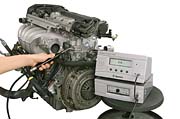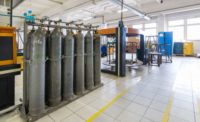Leak testing is an essential element in product quality testing with an assortment of methods that are appropriate for various applications. From the automotive industry to HVAC manufacturers, countless products and parts have to be tested for tightness to meet specifications and be granted the positive end of the accept or reject option. In fact, for many suppliers to the automotive industry, leak testing is an integrated part of production; 100% of their parts are tested against a leak standard to meet quality requirements.
Leak testing is almost always a matter of exactly measuring the leak rate of a manufactured part or product. Nothing is ever absolutely tight, but leak testing ensures that the product has been tested for maximum allowable leakage.
Leak testing can be done for several reasons, all of which are important. It can ensure that the outer environment is protected, ensuring that flammable, toxic or corrosive substances remain within an object's walls. It can also ensure that a liquid or gas that is essential to the function of a system such as brakes, an air conditioning unit or hydraulic valves remain contained within that system for the necessary period of time.

Bursting the bubble
Leak testing is important, but what leak testing method is the most practical and effective? For years, the simpler methods have been the most popular. Methods prevalent in every industry include water dunk testing and pressure decay. Each of these methods offers the advantage of minimal investment, but each of these methods also has drawbacks.
Dunking an object in water can be an effective method for determining if and where an object has a leak. Bubbles form at the source of the leak as a result of air pressure, and the amount of bubbles per minute can signify the size of the leak.
Water dunking provides minimal quality assurance. A small leak might make a few miniscule bubbles. If the leak is in a recess, air from the leak may collect inside the recess and stay there. Whether air bubbles rise to the surface or stick to the test object depends on surface tension.
Also, water dunking depends on the operator's involvement. When manually dipping an object into the water, the operator can inadvertently pull down air bubbles that mask bubbles from a small leak. The operator needs to wait until the object has cleared itself of non-leak related bubbles. Also, the operator's perspective can be limited; he or she may not be able to see a small leak if it is on the reverse side of the object.
Another drawback to the water dunking method is tied to the water itself. Water can have a number of debilitating effects on products, the most harmful being corrosion. End users do not want to employ a leak testing method that itself can be the cause of product failure.
Pressure decay
The pressure decay method is the most common method for leak testing. The technique measures the decrease in pressure in an object. A drop in pressure signifies a leak; the greater the pressure drop, the larger the leak. This method is convenient in that it can be automated and it is dry.
Pressure decay testing is not 100% accurate at all times and depends on a number of variables. For one thing, it is an incomplete method, as it cannot be used to pinpoint the location of a leak. Finding the source of the leak requires additional tests.
The success of pressure decay testing also depends on materials and temperatures. The ability to measure small leaks hinges on the internal volume of the object and whether the object is made of a rigid or flexible material. This test also relies on temperature because as temperatures rise, air is compressed inside the object and the pressure will not stabilize until the temperature has stabilized. Temperature can also be affected by elements outside the test. For example, when testing an aluminum object, the heat from a human hand or a breeze from an open door can alter test results and cause a false acceptance.
If a large object, such as a gasoline tank, needs to be tested, pressure decay testing is not the best choice. Objects that are large in volume require too long of a cycle time to get results from this method. Pressure decay testing only works for small-volume objects.
Finally, there can be issues with efficiently testing flexible plastic bottles and rubber parts using pressure decay, as they counteract the pressure decay by reducing their volume.
Tracer gases
In recent years, more complex methods, such as the use of tracer gases like helium and hydrogen, have proven effective for detecting and measuring a leak.
Helium is the most commonly used tracer gas for leak testing. This is because helium is the lightest of the inert gases and helium mass spectrometers are extremely sensitive to trace amounts of this gas. Mass spectrometers, commonly used to analyze unknown gases, have been developed for leak-testing applications. Set up to detect helium as it dissipates from an object, the mass spectrometers that use helium typically have an external pump that creates a vacuum outside the object, allowing for the relatively easy detection of helium atoms.
The helium method also has drawbacks. A mass spectrometer is a delicate piece of equipment and is expensive to maintain. Plus, the machine's pumps need to be regularly checked and serviced.
In addition, helium can cause problems. Helium is a highly viscous gas, and should it spill, it can be difficult to clear from the testing equipment. It also has a tendency to cling to surfaces. Helium is expensive, and it is a non-renewable natural resource so the price is expected to continue to rise.

The lightest gas
Perhaps the most misunderstood gas, at least in terms of its relevance to leak testing, is hydrogen. Hydrogen gas-based leak testing is actually a possible option for many reasons. Often ruled out by experts because of its perceived volatility, hydrogen can be safe when handled in the right form.
By using diluted hydrogen with nitrogen, the flammable concentration range can be avoided. In fact, standard hydrogen and nitrogen mixtures are commonly used as shielding gases for welding. A suitable concentration for leak testing, available in industrial grade from most gas suppliers, is 5% hydrogen and 95% nitrogen. According to ISO 10156, any hydrogen and nitrogen mixture containing less than 5.7% hydrogen is classified as nonflammable. Hydrogen can therefore be safely employed for leak testing.
The lightest element in the universe, hydrogen has half the viscosity of air or helium, so it spreads easily throughout the test object, penetrates leaks readily and vents away much easier than any other tracer gas.
Hydrogen is less expensive than helium, and is environmentally friendly. Hydrogen detectors cost less than most mass spectrometers.
The advent of a new type of hydrogen detectors has overcome another perceived hydrogen leak testing obstacle-lack of sensitivity. Based on microelectronic-hydrogen sensors, new hydrogen detectors have a high degree of sensitivity and high selectivity to hydrogen. They are also robust enough for industrial use, allowing the easy detection of leaks down to 5 x 10-7 cc/s.
Hydrogen leak detectors are easy for a nonengineer to operate. The test gas is simply injected into the test object, and a hand probe connected to the hydrogen detector is used to search for leaks. The detector indicates a leak with an audio signal that increases in frequency pitch the closer one is to the leak location. There is no need to create a vacuum, which means the user can save testing time.
Hydrogen leak testing can also be automated. Automotive component manufacturers, especially those located in Japan, are beginning to run more and more chamber-type, automated hydrogen testing systems on their components in an effort to save time and money.
Effective and safe, hydrogen leak detection is increasingly used by companies involved in industries such as automotive, refrigeration and air conditioning, medical, water and telecommunications. Hydrogen gas-based leak testing has been gaining in acceptance and usage by industry experts and academicians, and has also received official TÜV certification. NDT
Claes Nylander is president of Sensistor Technologies (Billerica, MA). He can be contacted at [email protected].





